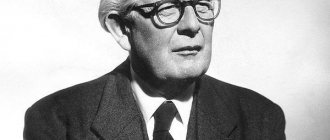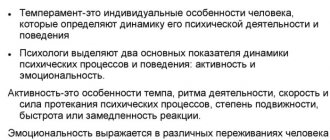Eight stages of personality development according to Erik Erikson. Theory of psychosocial development.
According to psychologist Erik Erikson, all people in their development go through eight crises , or conflicts.
Model of personality development.
Erikson developed a model of personality development that covers the entire period of human life. The main concept of his theory is “ego identity” or, in other words, the integrity of the individual. The formation of ego identity continues throughout a person’s life and goes through a number of stages.
Erikson identified 8 stages of personality development from birth to death.
| Age | Stage name |
| 0-1 | Trust or mistrust. |
| 2 — 3 | Independence or indecisiveness |
| 4 — 5 | Entrepreneurship or guilt |
| 6 — 11 | Skill or inferiority |
| 12 — 19 | Identity or role confusion |
| 20 — 25 | Early maturity. Intimacy or isolation |
| 26 — 64 | Average maturity. Productivity or inertia |
| From 65 years old | Late maturity. Integration or despair |
Stage 1.
Trust or distrust (0-1 year).
trust vs. mistrust
This stage covers the first year of life. At this stage, the sensory systems mature. That is, vision, hearing, smell, taste, and tactile sensitivity develop. A person is thirsty for new experiences, he masters the world .
At this stage, as at all subsequent ones, there are two paths of development: positive and negative.
| Positive way | Negative way |
| The child gets everything he wants. All the child’s needs are quickly met. As a result, the world is a cozy place where people can be trusted. The result of a positive path: The child develops the ability to form warm, deep, emotional relationships with other people, and optimism. If a small child could speak, he would say: “I am loved,” “I feel cared for, reliable.” | The mother’s focus is not on the child, but on caring for him or educational measures, or her own career, disagreements with relatives, anxieties of various kinds, etc. The result of the negative path: Distrust, suspicion, fear of the world and people, and pessimism are formed. |
Stage 1 Summary: oral-sensory. Psychosocial crisis: Basic trust – basic mistrust. Originally Answered: Can I trust the world? The strength is hope.
Up
Stage 2.
Independence or shame and indecisiveness (2-3 years)
autonomy vs. shame and doubt
This stage covers the second and third years of life. The second stage of personality development, according to E. Erikson, consists of the child forming and defending his autonomy and independence . It begins from the moment the child begins to walk . At this stage, the child masters various movements, learns not only to walk, but also to climb, open and close, hold on, throw, push, etc. Children enjoy and are proud of their new abilities and strive to do everything themselves .
| Positive way | Negative way |
| Parents give the child the opportunity to do what he is able to do, do not limit his activity, and encourage the child. At the same time, parents should unobtrusively but clearly limit the child in those areas of life that are dangerous for the children themselves and others. The child does not receive freedom, his freedom is limited. The result of a positive path: the child gains independence; autonomy; a feeling is developed that he controls his body, his aspirations, and to a large extent controls his environment; the foundations of free self-expression and cooperation are laid; self-control skills are developed without compromising one’s self-esteem; will. “Mom, look how great it is. I own my body. I can control myself." | Parents limit the child’s actions, parents are impatient, they rush to do for the child what he himself is capable of, parents shame the child for accidental offenses (broken cups); or vice versa, when parents expect their children to do something that they themselves are not yet able to do. The result of the negative path: the child develops indecision and lack of confidence in his abilities; doubt; dependence on others; a feeling of shame in front of others is consolidated; the foundations are laid for constrained behavior, low sociability, and constant vigilance. “My body is bad and I myself am bad”, “I have to control everything I do very carefully.” “I want to be independent, but I’m afraid that I won’t succeed.” |
Stage 2 Summary: Muscular-anal. Psychosocial crisis: Independence – shame and doubt. Originally Answered: Can I control my body? Strength is willpower.
Up
Stage 3.
3. Initiative or guilt (4-5 years).
initiative vs. guilt
Other translation options: enterprise and inadequacy.
Children aged 4-5 years transfer their research activity beyond their own bodies. They try to become independent and explore their limits. They learn how the world works and how they can influence it. The world for them consists of both real and imaginary people and things.
Positive path of development:
If children's exploration activities are generally effective, they learn to deal with people and things in a constructive way and gain a strong sense of initiative .
Parents, encouraging the child’s energetic and independent endeavors, recognizing his rights to curiosity and imagination, contribute to the development of initiative , expanding the boundaries of independence , and the development of creative abilities .
Negative path of development.
Close adults who severely limit freedom of choice, overly control and punish children, cause them to feel too much guilt . Children overwhelmed by guilt are passive , constrained and have little ability for productive work in the future.
Phrases from parents: “You can’t, you’re still small,” “Don’t touch!”, “Don’t you dare!”, “Don’t meddle where you shouldn’t!”, “You won’t succeed anyway, let me do it myself,” “Look, how upset your mother was with you"
Stage 3 Summary: Locomotor-genital, age 3-6 years. Psychosocial crisis: Initiative - guilt. Originally Answered: Can I become independent from my parents?
?
Strength is purpose.
Up
Stage 4.
Hard work or feelings of inferiority (6-11 years).
industry vs. inferiority
Between the ages of 6 and 11, children develop numerous skills and abilities at school, at home and among their peers.
According to Erikson's theory, the sense of self is greatly enriched as the child's competence in various areas increases
The child asks himself the question: Am I capable?
Positive way:
When children are encouraged to do what they love, learn new skills (tinkering, cooking, doing handicrafts, even if they are not so good and neat), when they are allowed to finish what they started, praised and rewarded for their results, then the child develops skill and ability for technical creativity.
Negative way:
Parents who see their children’s work as mere “pampering” and “messing up” contribute to the development of their feelings of inferiority.
A child's sense of competence and work ethic are also highly dependent on school performance. If a student learns educational material more slowly than his peers and cannot compete with them, then continuously falling behind in class develops a sense of inferiority in him.
Comparing oneself with one's peers is becoming increasingly important . During this period, negative assessment of oneself in comparison with others causes especially great harm.
Stage 4 Summary: Latent, age 6-11 years. Psychosocial crisis: hard work-inferiority. Answer to the question: Am I capable? Strengths: competence, confidence.
Up
Stage 5.
5.Identity or role confusion (12-19 years old).
identity vs. role confusion
Before adolescence, children learn a number of different roles - student or friend, older sibling, sports or music student, etc. During adolescence and adolescence, it is important to understand these different roles and integrate them into one coherent identity.
A teenager is looking for confidence, security, trying to be like other teenagers in his age group. He develops stereotypical behavior and ideals and often joins various groups or clans . Peer groups are very important for rebuilding self-identity. This is the second major attempt at developing autonomy (after stage 2), and it requires challenging parental and social norms .
Negative path of development: Boys and girls seek basic values and attitudes that cover all these roles. If they fail to integrate a core identity or resolve a major conflict between two important roles with opposing value systems, the result is what Erikson calls identity diffusion .
The teenager becomes distrustful, shy, insecure, filled with guilt and consciousness of his inferiority.
Stage 5 Summary: Adolescence, age 12-19 years. Psychosocial crisis: Self-identity - role confusion. Answer to the question: Who am I? Strength is loyalty.
Up
Stage 6.
6. Intimacy or isolation (20-25 years).
intimacy vs. isolation
In late adolescence and early adulthood, a central developmental tension is the conflict between intimacy and isolation. In Erickson's description, intimacy includes more than sexual intimacy. It is the same as the intimate feeling we have for spouses, friends, siblings, parents or other relatives.
This is the ability to give a part of yourself to another person of any gender, without fear of losing your own identity . Success in establishing this type of close relationship depends on how the five previous conflicts were resolved.
- For example, a person who has difficulty trusting others (stage 1) will have difficulty loving ;
- A person who needs to control himself (stage 3) will find it difficult to allow others to cross his boundary .
- Someone who feels inadequate will find it difficult to be intimate with others.
- And if a person is not sure of his identity (stage 5), then it will be difficult for him to share with others who he is .
Negative path of development.
The inability to establish calm, trusting personal relationships and/or excessive self-absorption leads to feelings of loneliness, social vacuum and isolation.
Read the articles: What is the reason for your loneliness. and 8 types of single (free) women.
Self-absorbed people may engage in very formal personal interactions and make superficial contacts, without showing real involvement in the relationship, because the increased demands and risks associated with intimacy pose a threat to them.
Stage 6 Summary: Early maturity, age 20-25 years. Psychosocial crisis: Intimacy-isolation. Originally Answered: Can I have an intimate relationship? The strong point is love.
Up
Stage 7.
Generativeness or stagnation (26-64 years).
generativity vs. stagnation
In adulthood, after previous conflicts have been partially resolved, men and women can pay more attention to and help other people. Parents sometimes find themselves helping their children. But not only. Productivity appears as the concern of the older generation about those who will replace them - about how to help them gain a foothold in life and choose the right direction.
Some people can direct their energy to solving social problems without conflict. But failure to resolve previous conflicts often leads to excessive self-absorption : one’s health, the desire to satisfy one’s psychological needs, to preserve one’s peace, etc.
Stage 7 Summary: Middle maturity, age 26-64 years. Psychosocial crisis: productivity-stagnation. Originally Answered: What am I going to do with the rest of my life? The strength is caring.
Up
Stage 8.
Ego integrity or despair (over 65 years old).
ego integrity vs. despair
In the last stages of life, people usually reconsider the life they have lived and evaluate it in a new way.
If a person’s life was filled with meaning and active participation in events, then he comes to the conclusion that he did not live in vain and fully realized what fate had given him.
Then he accepts his life entirely , as it is. But if life seems to him a waste of energy and a series of missed opportunities, he begins to feel despair.
It is obvious that one or another resolution of this last conflict in a person’s life depends on the cumulative experience accumulated in the course of resolving all previous conflicts.
8Summary: Stage 8. Late maturity, age from 65 years. Psychosocial crisis: Integrity I am despair. Originally Answered: Did my life have meaning? Strength: Wisdom.
Up
Erik Erikson - (eng. Erik Homburger Erikson; 1902, Frankfurt am Main - 1994, Massachusetts) - developmental psychologist and psychoanalyst.
Erikson contrasted Freud's theory, which divided psychological development into five stages, with his own scheme, in which there were eight such stages.
Erickson renamed the so-called “genital stage” “adolescence” and also added three more adult stages (6,7,8).
Erikson also owns the concept of “ego psychology,” emphasizing the role of the Ego as something more than the “handmaiden of the Id” (in Freudian ideas). It is the Ego that is responsible for organizing life, for ensuring harmony with the physical and social environment, for healthy personal growth; it is a source of self-confidence and personal identity.
Winner of the Pulitzer Prize for Nonfiction for his book Gandhi's Truth.
Share link:
- Click here to share content on Facebook. (Opens in a new window)
- Click to share on WhatsApp (Opens in new window)
Similar
What is Ego Integration?
The feeling of ego integration is the feeling of the integrity of one’s “I”. Initially, children do not have a sense of “I”. For them, the world around them and themselves are one and the same. The famous psychologist Jean Piaget emphasized that infants have no personality boundaries. They begin to form only by 2-3 years.
The highest level of personal development is a state when the world for a person becomes an ideal place to satisfy his needs (both spiritual and lower order). This state is called integration in psychology. From an evolutionary point of view, it means the highest degree of fitness.
The integrated personality is a clipboard between society and the inner world. She is able to avoid harmful factors, enhance beneficial ones, and even turn evil into good. A high degree of integration is characterized by professional development of the individual at a serious level.
According to Erikson, ego integration arises as a property of late life. But only if a person was able to experience numerous victories and defeats during his life and was an inspiration for others. Ego integration of an elderly person is a look at the past years and their positive assessment: “I am satisfied with the life I have lived.” Such people are not afraid of death. Indeed, in their descendants or creative achievements, they were able, in a certain sense, to gain immortality.
On the other side of the barricades are those who have “wasted their lives.” They look at the time they have lived with regret: it now seems like a series of missed opportunities. At the end of their lives, they feel that it is too late to start something. Erikson's theory of personality development identifies two types of mentality in such people. First, they regret that life cannot be lived again. Secondly, they deny their own shortcomings, projecting them onto the world around them. “Despair means that there is too little time left to choose another path to wholeness; That’s why old people try to embellish their memories,” Erikson writes in his works. Feelings of anxiety and self-pity in their extreme cases lead to mental disorders in old age. These are hypochondria, paranoia, depression and dementia.
School age
The fourth period corresponds to the ages of 6 to 12 years and is chronologically similar to the latent period in Freud's theory. Rivalry with a parent of the same sex has already been overcome, the child leaves the family and becomes familiar with the technological side of culture.
At this time, the child gets used to systematic learning, learns to win recognition by doing useful and necessary things.
The term “hard work”, “taste for work” reflects the main theme of this period; children at this time are absorbed in the fact that they strive to find out what comes out of what and how it works. The child's ego identity is now expressed as: “I am what I have learned.” While studying at school, children are introduced to the rules of conscious discipline and active participation. School helps the child develop a sense of hard work and achievement, thereby reaffirming a sense of personal strength. The ritual associated with school routines is perfection of execution.
Having built in the early stages feelings of trust and hope, autonomy and “will power,” initiative and determination, the child must now learn everything that can prepare him for adult life.
The most important skills he must acquire are the socialization aspects: cooperation, interdependence and a healthy sense of competition.
If a child is encouraged to tinker, do handicrafts, cook, is allowed to finish what he has started, and is praised for his results, then he develops a sense of competence, “skill,” confidence that he can master a new task, and his abilities for technical creativity develop.
If parents or teachers see the child’s work as mere pampering and an obstacle to “serious studies,” then there is a danger of developing in him a feeling of inferiority and incompetence, doubts about his abilities or status among his peers. At this stage, the child may develop an inferiority complex if adults' expectations are too high or too low.
Stage 7: Generative versus Stagnant (40-65 years)
In adulthood, people continue to build their lives and focus on their careers and family. Generativity means caring about people outside of their immediate circle of family and friends. As people begin to enter "middle age," their vision extends from their immediate environment, including themselves and their family, to a broader and more complete image that includes their society.
At this stage, people recognize that life is not all about them. Through their actions they hope to make a contribution that will become part of their legacy. When someone achieves this goal, they feel successful. On the other hand, if they do not feel that they have contributed, they may feel that they have not done or are not ready to do anything significant.
Important!
Generation is not needed for adults. However, not doing so can rob a person of a great sense of achievement.
Stage 1: Trust vs. Mistrust (0-18 months)
During the first stage of development, children learn to trust or not trust others. Trust has a lot to do with attachment, relationship management, and the extent to which a child expects others to meet his or her needs. Since the child is completely dependent, the development of trust is based on the reliability and quality of those who care for the child, especially the mother.
Important!
If parents do not provide a safe environment and do not meet the child's basic needs, they are likely to learn to expect nothing from others. Developing mistrust can lead to frustration, suspicion, or lack of feelings.
Youth
The fifth stage in Erikson's life cycle diagram, from 12 to 20 years of age, is considered the most important period in human psychosocial development:
“Youth is the age of final establishment of a dominant positive identity.
It is then that the future within the foreseeable limits becomes part of the conscious plan of life.” This is the second major attempt to develop autonomy, and it requires challenging parental and social norms.
The teenager is faced with new social roles and associated requirements. Teenagers evaluate the world and their attitude towards it. They think about the ideal family, religion, and the social order of the world.
There is a spontaneous search for new answers to important questions: Who is he and who will he become? Is he a child or an adult? How do his ethnicity, race, and religion affect how people view him? What will be his true authenticity, his true identity as an adult?
Such questions often make the teenager painfully concerned about what others think of him and what he should think about himself. Ritualization becomes improvisational, and the ideological aspect is highlighted in it. Ideology provides young people with simplified but clear answers to major questions related to identity conflict.
The teenager’s task is to put together all the knowledge he has by this time about himself (what kind of sons or daughters they are, students, athletes, musicians, etc.) and create a single image of himself (ego identity), including awareness of how the past and the expected future.
The transition from childhood to adulthood causes both physiological and psychological changes.
Psychological changes manifest themselves as an internal struggle between the desire for independence, on the one hand, and the desire to remain dependent on those people who care about you, and the desire to be free from the responsibility of being an adult, on the other. Faced with such confusion about his status, a teenager always seeks confidence, security, trying to be like other teenagers in his age group. He develops stereotypical behavior and ideals. Peer groups are very important for restoring self-identity. The destruction of strictness in dress and behavior is inherent in this period.
The positive quality associated with successfully overcoming the crisis of adolescence is self-fidelity, the ability to make your own choice, find a path in life and remain faithful to your obligations, accept social principles and adhere to them.
Erikson considers drastic social changes and dissatisfaction with generally accepted values as a factor that interferes with the development of identity, contributing to a feeling of uncertainty and inability to choose a career or continue education. A negative way out of the crisis is expressed in poor self-identity, a feeling of uselessness, mental discord and aimlessness; sometimes teenagers rush towards delinquent behavior. Excessive identification with stereotypical heroes or representatives of the counterculture suppresses and limits the development of identity.
Stage 3: Initiative vs. Guilt (3-5 years)
In Erikson's third stage, children begin to strengthen their power and control over the world through play, which is an invaluable basis for social interactions. When they achieve the ideal balance of individual initiative and willingness to work with others, they develop a sense of purpose.
Important!
Children who are successful at this stage feel confident to lead others. Those who do not achieve these qualities are likely to feel guilty, have doubts and lack initiative.
Guilt is good in the sense that it shows children's ability to recognize when they have done something wrong. However, excessive or undeserved guilt can cause children to give up on problems because they do not feel able to confront them. Guilt can often fuel fear.
Stage 2: Autonomy vs. Shame/Doubt (18 months - 3 years)
In the second stage, children gain a certain degree of control over their bodies, which in turn increases their independence. By successfully solving problems on their own, they gain a sense of independence. Thus, by allowing children to make decisions and gain control, parents can help children develop a sense of autonomy.
Important!
Children who successfully pass this stage usually have healthy self-esteem. Erikson believed that an imbalance between autonomy, shame, and doubt would lead to the belief that children can act intentionally and within reasonable limits.
Erickson biography
The son of a Danish father and a Jewish mother, the future great psychologist and psychoanalyst Erik Erikson was born in 1902 in Germany, near Frankfurt. His parents divorced before he was born, and his mother subsequently married Dr. Theodor Homburger. Little Eric did not know for several years that Dr. Homburger was his stepfather. Later, when he signed his first articles on psychoanalysis and psychotherapy, Erickson used his stepfather's surname, although when he became a naturalized American citizen in 1939, he chose his father's surname.
Unlike other personologists, Erickson did not receive formal college education after graduating. He attended a "humanistic gymnasium" in Germany and, although a mediocre student, excelled in the study of history and art. Shortly after graduating from high school, Erickson traveled to Central Europe, despite his stepfather encouraging him to become a doctor. A year later he entered art school, but soon could no longer sit still and went to Munich to study at the prestigious Academy of Fine Arts. Two years later, Erickson traveled to Italy, visiting Florence, sunbathing and wandering art galleries.
In 1927, the "work freeze" ended and he was hired as a teacher at a small American experimental school in Vienna on the recommendation of a classmate, Peter Blos. The school was founded by Anna Freud for children whose parents were trained in psychoanalysis. Some of Erikson's young students were themselves psychoanalysts, and "Herr Erik," as he was affectionately known, joined them.
Erickson began studying psychoanalysis at a mountain resort near Vienna. There, as a private teacher, he first met the Freud family and was then accepted as a candidate for teaching at the Vienna Psychoanalytic Institute. From 1927 to 1933, Erikson continued his psychoanalytic research with Anna Freud. This was his only formal academic training, other than a certificate issued by the Maria Montessori Teachers' Association in Vienna. Maria Montessori in Vienna. In Vienna, Erikson married Canadian Joan Serson, who also attended Anna Freud's experimental school. In 1933, Erikson's family (including two sons) traveled to Copenhagen, where Erikson attempted to gain citizenship and help establish a center for teaching psychoanalysis in that country. When it became obvious that this idea was not feasible, the family emigrated to the United States and settled in Boston, where a psychoanalytic society had been founded a year earlier. Erickson practices in Boston for the next two years, specializing in the treatment of neuroses, anxiety, sleep disorders and other disorders in children. He also served on the staff of the Henry Murray Clinic at Harvard and served as a fellow in psychology in the Department of Neuropsychiatry at Harvard Medical School. Erikson was even accepted as a candidate for a doctorate in psychology at Harvard, but he dropped out of that research program after failing his first course.
In 1936, Erickson was hired by Yale University School of Medicine as a faculty member. In 1938, he went on an expedition to the Pine Ridge Reserve in South Dakota to observe the raising of children among the Sioux Indians. This study marked the beginning of Erikson's interest in studying the influence of culture on child development, a topic to which he devoted much of his subsequent professional life.










